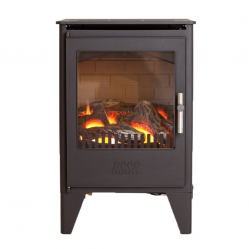Technical Details
| Product Title | Parkray Consort 5 Natural Gas Log Effect Stove, Remote Control |
|---|---|
| Product Keyword | Parkray Consort 5, Gas Stove, Log Effect, Natural Gas, Remote Control |
| Energy Efficiency | E |
| Output (Nominal) | 3.5kW |
| Output (Maximum) | 4.7kW |
| Fuel | Gas - NG |
| Height | 551mm |
| Width | 395mm |
| Depth | 390mm |
| Nominal Output (Range) | 3kW - 5kW |
| Width (Range) | 300mm - 400mm |
| Nett Efficiency (%) | 71% |
| Style | Traditional |
| Chimney Type | Class 1 & 3 |
| Height (Range) | 500mm - 600mm |
Product Description
Parkray Consort 5 Natural Gas Log Effect Stove with Remote Control
- Realistic log effect gas burner providing a warm and inviting atmosphere
- Convenient remote control operation for ease of use from anywhere in the room
- Efficient natural gas usage to keep running costs low
- Compact design, ideal for medium-sized living spaces
- High-quality steel construction with a durable finish for longevity
- Simple to install with minimal maintenance required
- Thermostatic control for maintaining a consistent temperature
- Oxygen depletion sensor for safety and peace of mind
- Flame failure device to automatically shut off gas supply if the flame goes out
- Large viewing window for an unobstructed view of the flames
- Heat output of up to 4.7kW, suitable for heating a small to medium-sized room
- Modern design that fits seamlessly with different interior styles
Reviews
Gas Stoves > Traditional Gas Stoves

Traditional Gas Stoves
Our beautiful range of traditional gas stoves combine the best of both worlds, traditional looking stoves but with flames at the click of a switch. These traditional gas stoves are available in a range of different sizes and outputs to suit your requirements and room sizes. We supply a wide range of high efficiency gas fires and stoves, meaning they will cost significantly less to run compared to an older gas stove or appliance which will not produce as much heat output. These traditional gas fires can be installed using a balanced or conventional flue system, depending on the requirements, location of the appliance and space available. Our traditional gas stoves and fires are available with different fuel effects (usually logs or coal) and many appliances are available with optional remote controls so you can control the flames (and therefore heat output) from the comfort of your sofa.




